|
Limitar tu búsqueda
[+–] Creator
- Aguayo Tellez, Ernesto (2)
- Aguilera, Nelly (7)
- Amuedo Dorantes, Catalina (2)
- Ayala Gaitán, Edgardo A. (2)
- Benavides, Guillermo (2)
- Blair, Randall (2)
- Calderón-Madrid, Angel (2)
- Calónico, Sebastián (1)
- Camillo Rosati, Furio (2)
- Campos Vázquez, Raymundo M. (2)
- Campuzano, Larissa (2)
- Castellanos, Sara G. (2)
- Coello Levet, Carlo G. (2)
- Cruz Rivero, Carlos (2)
- Cuilty, Emilio (2)
- De la Torre, Rodolfo (4)
- Gameren, Edwin van (2)
- García Moreno, Vicente (2)
- Heimann, Ursula (2)
- Hernández Ángeles, Domingo F. (2)
- Hu, Chiung-Yin (1)
- Huidobro Ortega, Alberto (4)
- Hysenbegasi, Alketa (1)
- Jarillo Rabling, Brenda (2)
- Le Thi, Mai Linh (2)
- Levy, Dan (2)
- Lima, Martín (2)
- Luna Ruiz, Gabriela A. (2)
- López Rodríguez, Patricia (3)
- López-Calva, Luis Felipe (1)
- Manuel Gutiérrez, Diana (2)
- Martin, Philip (1)
- Martinez, Jose (2)
- Martínez Cárdenas, Rubén (2)
- Martínez, Gabriel (6)
- Merino Sanz, María (2)
- Miranda, Martha (5)
- Morales Barrera, Raquel (2)
- Morales, F. Javier (2)
- Moreno, Lorenzo (2)
- Muñoz Izquierdo, Carlos (2)
- Navarrete Luna, Juan (2)
- Negrín, José L. (2)
- Ocampo, Diadelfa (2)
- Orcí, Sandra (2)
- O’Keefe, Mary (2)
- Patrinos, Harry Anthony (2)
- Pozo, Susan (3)
- Pérez Yarahuán, Gabriela (2)
- Ramírez Medina, Edgar (2)
- Robison, Lindon J. (1)
- Rossi, Mariacristina (2)
- Sana, Mariano (1)
- Sandoval, Héctor H. (2)
- Santibáñez, Lucrecia (2)
- Santos, María Emma (1)
- Schreiner, Mark (2)
- Scott, John (4)
- Siles, Marcelo E. (1)
- Sinha, Tapen (2)
- Soloaga, Isidro (3)
- Torán, Mariana A. (2)
- Vaca Domínguez, Beatriz (2)
- Vargas Chanes, Delfino (2)
- Velázquez, César (2)
- Woodruff, Christopher (2)
- Zapata Álvarez, Gabriela (2)
- Zaragoza Castillo, Ricardo (2)
- de la Cruz, Paúl (2)
- de la Fuente, Alejandro (2)
- Álvarez, Jesús (2)
- Ñopo, Hugo (1)
[+–] Editorial
[+–] Fecha
[+–] Formato
[+–] Idioma
[+–] Tipo de documento
[+–] Tipo de recurso
[+–] Classification
|

|
|
Do investments in public spaces generate social capital? Evidence for Mexico
The formation of social capital is critical for developing countries. This paper investigates the effects of attempts to recover public spaces in marginalized areas of Mexico. The effects are estimated through balancing in the propensity scores. We focus on the results of perception of safety, support and social capital. When efforts are made to recover public spaces, the perception of safety...
|

|
|
|
|

|
|
The effect of the perception of violence on social capital in Mexico
Increasing levels of violence in Mexico, which have the potential to damage the very fabric of 1 society, as well as impact key economic variables, led us to analyze the effect that changes in the perception of violence had on social capital fluctuations (including associative capital) between 2006 and 2011. This was a period in which an anti-violence and anti-organized crime policy was launched...
|
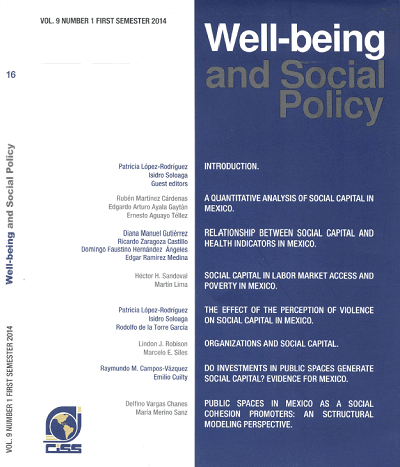
|
|
|
|

|
|
Social capital in labor market access and poverty in Mexico
Social capital, defined as the set of social networks that a person has in order to obtain benefits, is used by the population as a mechanism for providing resources, to cushion shocks in consumption and to obtain information on available employment opportunities. This study employs a logistic model to characterize the manner in which people access the labor market in Mexico through the use of...
|

|
|
|
|

|
|
Relationship between social capital and health indicators in Mexico
This study analyzes the relationship between social capital types and access to health services in Mexico. To this end, access to healthcare data from the 2006 ENCASU and 2011 ENCAS was validated using 2006 and 2012 ENSANU results. Indicators were found to be consistent. A statistical analysis of the distribution of social capital and health indicators by region, as well as by rural or urban area...
|
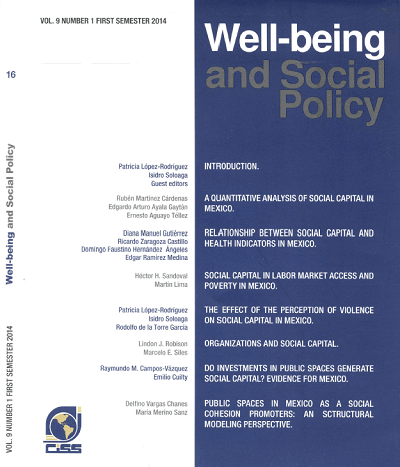
|
|
|
|

|
|
A quantitative analysis of social capital in Mexico
Se ha relacionado el capital social a la eficiencia en los mercados (Arrow, 1972), al refuerzo del contrato (Durlauf y Fafchamps, 2004) y en general al desarrollo y bienestar (Keefer y Knack 1997; Putnam 2000; Knack y Zak 2003). En el presente trabajo hemos investigado los determinantes del capital social empíricamente, centrándose en tres medidas comunes aproximadas de este: dos ligadas a la...
|

|
|
|
|

|
|
Analysis of the use of financial services by companies in Mexico: What does the 2009 Economic Census tell us?
We present a descriptive analysis of the results of Mexico's 2009 Economic Census regarding the use of bank credit and accounts by productive entities (companies). INEGI was requested to prepare a set of statistics regarding various company characteristics that are relevant to the decisions made by institutions offering banking services. Information was grouped according to company size and to...
|
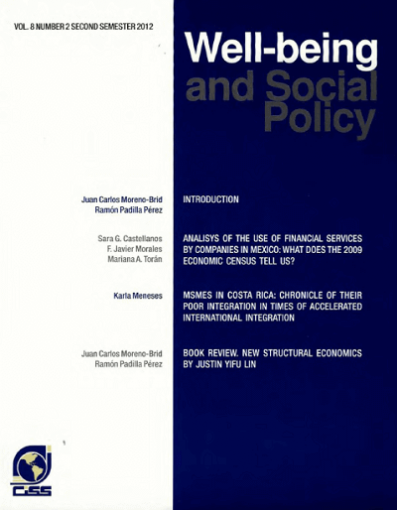
|
|
|
|

|
|
Promised and actual benefits in mexican social security fot rhe transtion generation
Este artículo presenta un conjunto de mediciones de los costos y beneficios reales del plan general de retiro por jubilación proporcionado a los ciudadanos por parte del Sistema Mexicano de Pensiones (SMP), que son necesarias para evaluar las decisiones de los trabajadores en cuanto a la contribución a la seguridad social (es decir, trabajar en el sector formal) y al retiro. El SMP ofrece dos...
|

|
|
|
|

|
|
Strategic map of financial inclusion: a working tool
Various circumstances make difficult the rigorous study of processes, strategies and impact of V the efforts of financial inclusion and penetration, either at the academie level, in the public policy area or in companies and organizations of financial services industry. The central problem in Mexico has been the lack of a unified agreement on the definition and the low comprehension level of the...
|
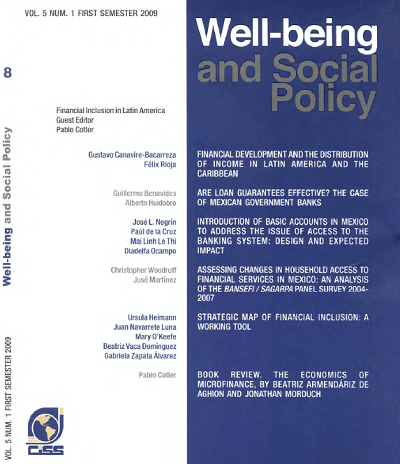
|
|
|
|

|
|
A simple poverty scorecard for Mexico
This study uses Mexico's 2008 National Household Survey of Income and Expenditure to I construct an easy-to-use scorecard that estimates the likelihood that a household has income below a given poverty line. The scorecard uses ten simple indicators that field workers can quickly collect and verify. Poverty scores can be computed on paper in the field in about five to ten minutes. The scorecard's...
|
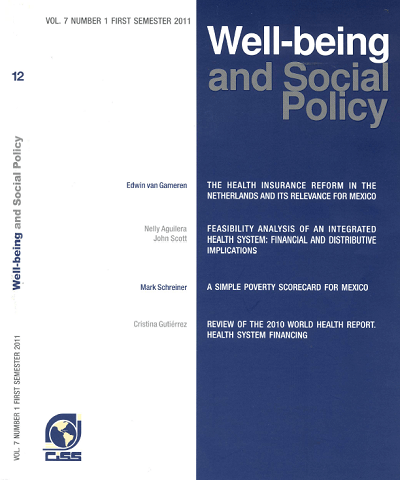
|
|
|
|

|
|
Feasibility analysis of an integrated health system: financial and distributive implications
The document presents spending projections and projections of the distributive incidence for an Integrated Health System under three basic scenarios: status quo, a two pillar scheme (financed through general taxes and private spending) and a three pillar scheme (financed through general taxes, social security contributions and private spending). By presenting these simulations, the study enhances...
|
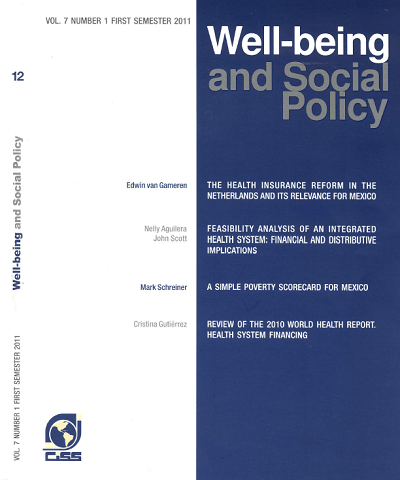
|
|
|
|

|
|
The health insurance reform in the Netherlands and its relevance for Mexico
Alrededor del mundo se observan dos versiones de la organización de los seguros de salud; la seguridad social basada en el empleo, y los servicios nacionales de salud. En Latinoamérica regularmente se usa la primera, pero se está lejos de lograr la cobertura universal. En los Países Bajos encontramos una peculiar mezcla de obligaciones públicas y responsabilidades privadas. La cobertura universal...
|

|
|
|
|

|
|
Natural disasters and poverty in Latin America: welfare impacts and social protection solutions
The Inter-American Conference on Social Security (CISS) and the United Nations Development Programme (UNDP) Office in Mexico jointly organized the conference “Natural Disasters in Latin America: Welfare Impacts and Social Protection Solutions” held in Mexico City in January 2010. The main objectives of the conference were to improve the understanding of (i) how natural disasters affect...
|
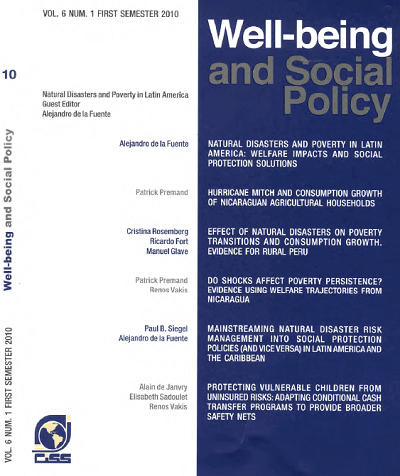
|
|
|
|

|
|
Book review. Informe de evaluación de la política de desarrollo social en México 2008, CONEVAL
The Evaluation Report on Social Development Policy in Mexico was published by the National Council for Social Development Policy Evaluation (CONEVAL) in 2008. The Council is one of the constituting elements of the new institutional framework to evaluate the public sector performance, particularly social development policies that were put in place mostly during the first decade of this century....
|

|
|
|
|

|
|
Impact on earning, employment prospects and timing out of unemployment of mexican programs targeted at unemployed individuals: challenges
his paper presents estimates of the impact of programs for unemployed workers on the performance of program beneficiaries in Mexico. We emphasize the significance of applying methodologies capable of avoiding statistical bias attributable to unobserved variables when measuring the impact on earnings and allowing to us properly estimate unemployment duration and work status after exiting from...
|
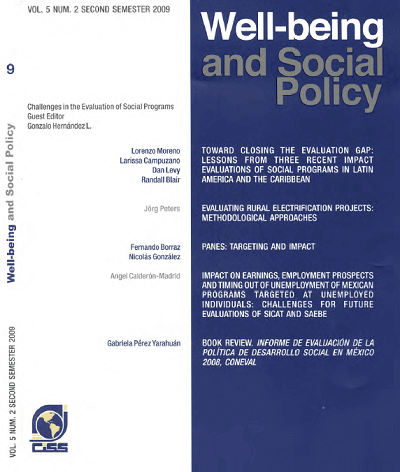
|
|
|
|

|
|
Toward closing the evaluation gap: lessons from three recent impact evaluations of social programs in Latin America and the Caribbean
Despite recent growing demand from funders and governments, rigorous impact evaluations in Latin America and the Caribbean remain the exception rather than the rule. Many commissioned impact evaluations are methodologically weak, and thus only marginally useful in assessing the impact of social interventions. Other impact evaluations feature strong research methodologies at their conception, but...
|

|
|
|
|

|
|
Seguridad social universal centrada en el ciudadano
Este ensayo revisa la situación de la protección social en México, así como diversas propuestas y opciones para su reforma. Una guía es el concepto de piso de protección social que han definido la Organización Internacional del Trabajo y la Organización Mundial de la Salud. Se tratan temas de forma más general bajo los grandes apartados de programas de familia, pensiones, salud y empleo, así como...
|
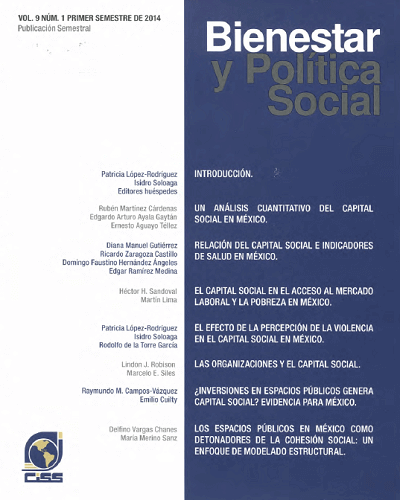
|
|
|
|

|
|
Los espacios públicos en México como detonadores de la cohesión social: un enfoque de modelado estructural
Esta investigación evaluó los efectos de varios factores contextuales (por ejemplo, la inseguridad vecinal, la evaluación de los espacios públicos, la infraestructura, los comportamientos de bajo riesgo) en materia de cohesión social y de satisfacción residencial, en el contexto de individuos de situación socioeconómica baja y media-baja que se encuentran cerca de espacios públicos (parques e...
|
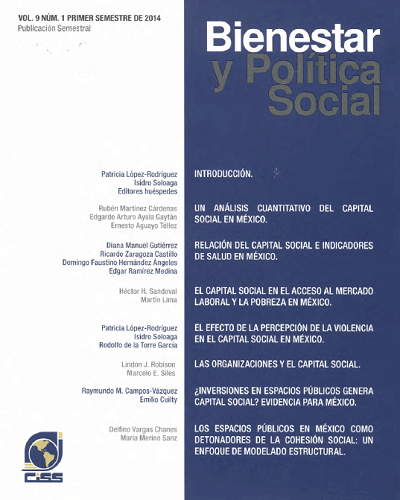
|
|
|
|

|
|
Gasto catastrófico en salud y elasticidades ingreso por tipo de gasto en servicios de salud en México
El objetivo de este artículo es contextualizar económicamente el gasto en salud dentro del patrón de gasto familiar de los hogares mexicanos. Se analiza información de la Encuesta Nacional Ingreso Gasto de los Hogares (ENIGH) de México de 2004 sobre: estructura del gasto en los hogares, gasto en salud y elasticidades ingreso-gasto en salud; de acuerdo quintiles de ingreso y a la condición de...
|
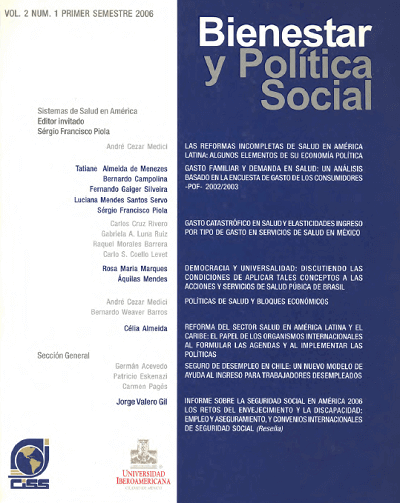
|
|
|
|

|
|
Conflicto y poder: el sindicato de maestros y la calidad educativa en México
El Sindicato Nacional de Trabajadores de la Educación (SNTE) representa a más de 1 millón de agremiados y es el sindicato más grande de América Latina. Este estudio utiliza datos de las pruebas nacionales aplicadas por el Instituto Nacional para la Evaluación de la Educación (INEE) así como información generada por la Secretaría de Educación Pública y otras fuentes para analizar la relación que...
|

|
|
|
|

|
|
¿Son efectivas las garantías de crédito? El caso de los bancos del gobierno mexicano
Los Bancos del Gobierno Mexicano ofrecen garantías de crédito a bancos privados a fin de estimular el crédito dirigido a empresas pequeñas y medianas no financieras y esta política se examina en este artículo. La aplicación de datos representativos al análisis de estática comparativa de la decisión de uso de garantías sugiere que, como están diseñadas actualmente, son justificables desde un punto...
|
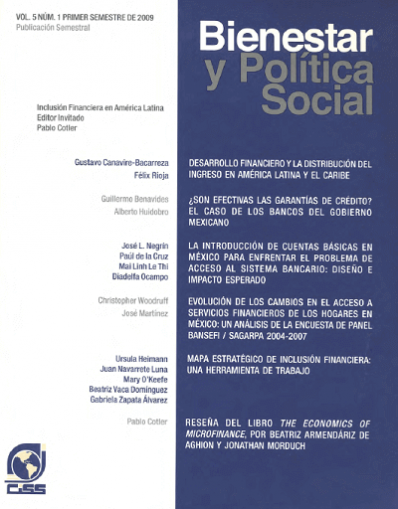
|
|
|
|
|